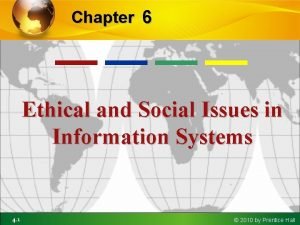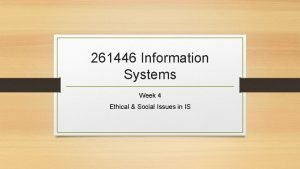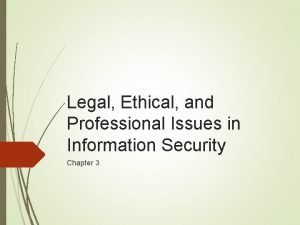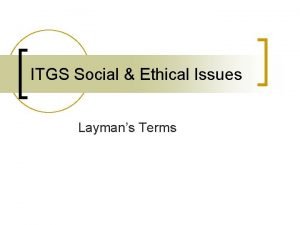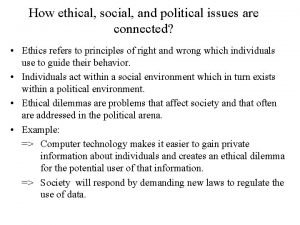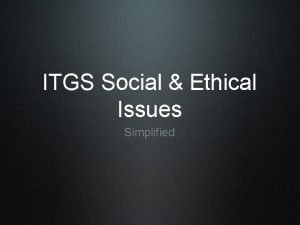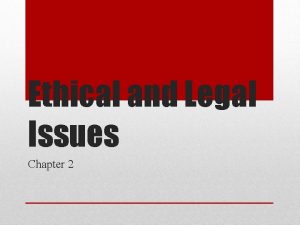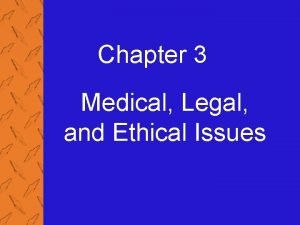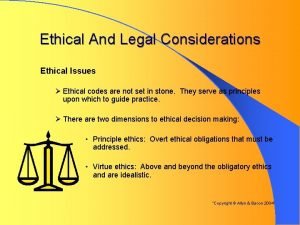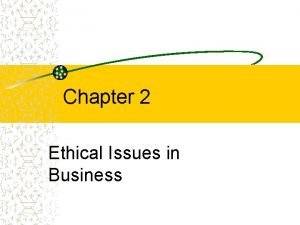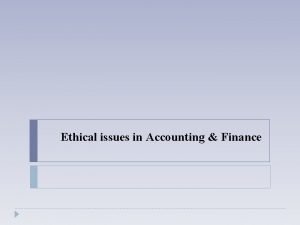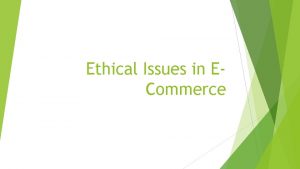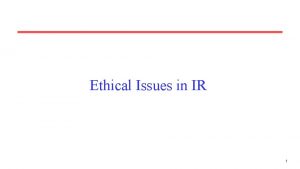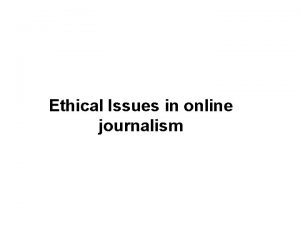Chapter 4 Ethical and Social Issues in Information













- Slides: 13

Chapter 4 Ethical and Social Issues in Information Systems 4. 1 © 2007 by Prentice Hall

Management Information Systems Chapter 4 Ethical and Social Issues in Information Systems LEARNING OBJECTIVES • Analyze the relationships among ethical, social, and political issues that are raised by information systems. • Identify the main moral dimensions of an information society and specific principles for conduct that can be used to guide ethical decisions. • Evaluate the impact of contemporary information systems and the Internet on the protection of individual privacy and intellectual property. • Assess how information systems have affected everyday life. 4. 2 © 2007 by Prentice Hall

Management Information Systems Chapter 4 Ethical and Social Issues in Information Systems Does Location Tracking Threaten Privacy? • Problem: New opportunities from new technology and need for greater security. • Solutions: Redesigning business processes and products to support location monitoring increases sales and security. • Deploying GPS and RFID tracking devices with a location tracking database enables location monitoring. • Demonstrates IT’s role in creating new opportunities for improved business performance • Illustrates how technology can be a double-edged sword by providing benefits such as increased sales and security while compromising privacy. 4. 3 © 2007 by Prentice Hall

Management Information Systems Chapter 4 Ethical and Social Issues in Information Systems Understanding Ethical and Social Issues Related to Systems • A model for thinking about ethical, social, and political issues • Five moral dimensions of the information age • • • Information rights and obligations Property rights and obligations Accountability and control System quality Quality of life • Key technology trends that raise ethical issues 4. 4 © 2007 by Prentice Hall

Management Information Systems Chapter 4 Ethical and Social Issues in Information Systems Understanding Ethical and Social Issues Related to Systems The Relationship Between Ethical, Social, and Political Issues in an Information Society The introduction of new information technology has a ripple effect, raising new ethical, social, and political issues that must be dealt with on the individual, social, and political levels. These issues have five moral dimensions: information rights and obligations, property rights and obligations, system quality, quality of life, and accountability and control. 4. 5 Figure 4 -1 © 2007 by Prentice Hall

Management Information Systems Chapter 4 Ethical and Social Issues in Information Systems Understanding Ethical and Social Issues Related to Systems Data for Sale • Read the Interactive Session: Management, and then discuss the following questions: • Do data brokers pose an ethical dilemma? Explain your answer. • What are the problems caused by the proliferation of data brokers? What management, organization, and technology factors are responsible for these problems? • How effective are existing solutions to these problems? • Should the U. S. federal government regulate private data brokers? Why or why not? What are the advantages and disadvantages? 4. 6 © 2007 by Prentice Hall

Management Information Systems Chapter 4 Ethical and Social Issues in Information Systems Ethics in an Information Society 4. 7 © 2007 by Prentice Hall

Management Information Systems Chapter 4 Ethical and Social Issues in Information Systems The Moral Dimensions of Information Systems • Information rights: Privacy and freedom in the Internet Age • The European directive on data protection • Internet challenges to privacy • Technical solutions • Property rights: Intellectual property • Trade secrets • Copyright • Patents • Challenges to intellectual property rights 4. 8 © 2007 by Prentice Hall

Management Information Systems Chapter 4 Ethical and Social Issues in Information Systems The Moral Dimensions of Information Systems How Cookies Identify Web Visitors Cookies are written by a Web site on a visitor’s hard drive. When the visitor returns to that Web site, the Web server requests the ID number from the cookie and uses it to access the data stored by that server on that visitor. The Web site can then use these data to display personalized information. Figure 4 -3 4. 9 © 2007 by Prentice Hall

Management Information Systems Chapter 4 Ethical and Social Issues in Information Systems The Moral Dimensions of Information Systems • Accountability, liability, and control • Computer-related liability problems • System quality: Data quality and system errors • Quality of life: Equity, access, and boundaries • Balancing power: Center versus periphery • Rapidity of change: Reduced response time to competition • Maintaining boundaries: Family, work, and leisure • Dependence and vulnerability 4. 10 © 2007 by Prentice Hall

Management Information Systems Chapter 4 Ethical and Social Issues in Information Systems The Moral Dimensions of Information Systems • Quality of life: Equity, access, and boundaries (cont’d) • Computer crime and abuse • Employment: Trickle-down technology and reengineering job loss • Equity and access: Increasing racial and social class cleavages • Health risks: RSI, CVS, and Technostress 4. 11 © 2007 by Prentice Hall

Management Information Systems Chapter 4 Ethical and Social Issues in Information Systems The Moral Dimensions of Information Systems The Spamming Problem This figure shows the major types of products and services hawked through spam e-mail messages and the industries that receive the most spam. Figure 4 -5 4. 12 © 2007 by Prentice Hall

Management Information Systems Chapter 4 Ethical and Social Issues in Information Systems The Moral Dimensions of Information Systems The Internet: Friend or Foe to Children? • Read the Interactive Session: Organizations, and then discuss the following questions: • Does use of the Internet by children and teenagers pose an ethical dilemma? Why or why not? • Should parents restrict use of the Internet by children or teenagers? Why or why not? 4. 13 © 2007 by Prentice Hall
 Chapter 4 ethical and social issues in information systems
Chapter 4 ethical and social issues in information systems 4 components of an information system
4 components of an information system Ethical and social issues in information systems case study
Ethical and social issues in information systems case study Ethical and social issues in information system
Ethical and social issues in information system Ethical and social issues in information systems
Ethical and social issues in information systems Legal ethical and societal issues in media and information
Legal ethical and societal issues in media and information State legal ethical and professional aspects of security
State legal ethical and professional aspects of security Legal and ethical issues in information security
Legal and ethical issues in information security Social ethical issues itgs
Social ethical issues itgs How ethical social and political issues are connected
How ethical social and political issues are connected Ethical social and political issues in e-commerce
Ethical social and political issues in e-commerce Itgs social and ethical issues
Itgs social and ethical issues Chapter 2 ethical and legal issues
Chapter 2 ethical and legal issues Medical legal and ethical issues chapter 3
Medical legal and ethical issues chapter 3



